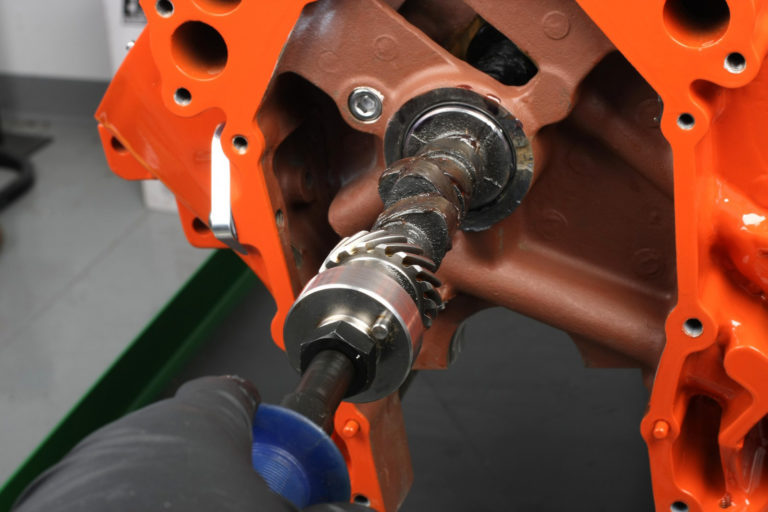
Have you ever wondered why one camshaft makes more power than the other?
Would you like to compare the behaviors of multiple cams without ever doing a cam swap?
Written descriptions of idle quality, power range, compression, gear, and converter requirements only go so far when the same cam fits in a 283 or 406 engine.
Fortunately, understanding camshaft specs and how they relate to specific valve events is a great way to benchmark an engine’s performance.
Note: This is part one of a two-part series on Comparing Camshafts. We take a much closer look at cam timing (including the four engine strokes and the effect of the pistons pumping air in and out of the intake and exhaust ports) in part two. You can read it here: Comparing Camshafts (Part 2): Consider Individual Timing Events When Choosing a Cam
But before we go further, let’s take a quick stroll down memory lane.
- In the 1950s, cams were commonly called 1/2-race, 3/4-race, and full-race. The problem with that terminology is that it was often subjective—one person’s 1/2-race cam could be another’s 3/4-race, and so on.
- During the 1970s, camshaft companies were using a spec called “advertised duration.” This was a step forward, but the companies still used different measurement standards, so one company’s “292” could be smaller than another company’s “288.”
- By the 1980s and 90s, most companies were publishing “duration at .050 in. lift” numbers. Customers could use seat, .050 in. and .200 in. numbers to compare lobe intensity.
All these previous methods gave us these generally accepted truths:
- Wider lobe separation (less overlap) makes for a better idle than narrow lobe separation (more overlap).
- Advancing the cam makes more low end torque. Retarding results is more on the top end.
- Longer duration cams make more power up top, but suffer from a rough idle, and lack low-end.
- Nitrous and blower cams have wider lobe-separation numbers.
Unfortunately, this led to generalities like “Always install a cam 4 degrees advanced” and “Never run less than 110 degrees of lobe separation on the street.”
In reality, nothing could be further than the truth.
So, if you want something a little more dialed-in than a “3/4-race camshaft” for your engine—read on.
The engine cares only about individual valve timing events.
That’s because these four valve timing events create duration, lobe centerlines, lobe separation, cam advance, and overlap numbers….not the other way around!
What are these four important events?
- Exhaust valve opening
- Exhaust valve closing
- Intake valve opening
- Intake valve closing
By choosing these events independently, you’ll have more control of the engine’s behavior.
***
Want to see how a camshaft is made? Check out this factory tour.
***

332 interceptor specaial 58
Howard mek cam. intake opens 16.5 Closes 52.5 exhaust opens 11.5 Closes 63.5 valve lift intake 0.525 exhaust 0.508 Lobe sep.112
[…] Editor’s Note: This is the second half of an article on how to interpret cam specs to select the right cam for your engine and vehicle needs. You can read the first half here: Comparing Camshafts: A History of Camshaft Specs and Choosing the Right Cam. […]
[…] Comparing Camshafts: A History of Camshaft Specs and Choosing the Right Cam […]
Buenos días amigos. Tengo una gran duda por qué no sé cómo calcular el árbol de levas que realmente necesito para mi motor Chevrolet 350 que voy a instalar en mi Malibú el cual estoy restaurando. He comprado algunos componentes como carburador edelbrock cuatro barriles de 650cfm un camarín de admisión WEIAND un juego de headers marca HOOKER COMPETICION. pero me hace falta el polémico árbol de levas alguien me recomendó este kit K12-671-4 nostalgia L79. Me gustaría saber si queda bien a mí motor ya que no quiero que me quede tan brincon pero si alegre para la calle. Mucho sabré apreciar su recomendación
[…] Comparing Camshafts: A History of Camshaft Specs and Choosing the Right Cam […]
Ok, so I have an older 98 GMC with a 5.7/350 motor, I am purchasing a travel trailer with a weight of around 4k, obviously I don’t need high end power but I do need low end torque.
Question is what cam would you recommend?
Hi Jim. You may want to take a look at the COMP cca-08-530-8 hydraulic roller. (https://www.summitracing.com/parts/cca-08-530-8/overview/)
It’s a 206/212 duration, .477/.471 lift and has 115 lobe separation.
It’s designed for exactly what you’re wanting to do with it.
So how do you choose those 4 events?
I need 1989 dodge Cummins camshaft and head gasket for a strait 6 .4 wheel drive D350. 5.9
I have a 2006 Silverado 1500 crew cab with the 5.3 LS engine, 3.73 axle ratio and 31″ tires. I spend most of my time in the idle-3500 RPM range. What valve events should I be looking at to boost low speed torque/responsiveness? I had pondered on these valve events @.050 and wanted your input.
IVO -9
IVC 33
EVO 43
EVC -15
204/208 115 LSA with 4 degree advance
[…] One area of confusion is certainly a camshaft timing card. All aftermarket and production camshafts use a series of terms and specifications to identify their operating characteristics. These may seem obscure and even perhaps baffling, but in fact these cam specifications lay out a simple way of determining exactly how a particular camshaft will operate in the engine. That’s vitally important when it comes to choosing the right camshaft. […]
Does anyone have any information on a cam stamped C396P out of a big block chevy